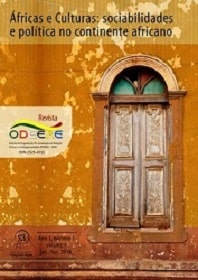An African preacher in the Portuguese inquisition: Bento de Jesus and the ideology of slavery in Cape Verde in the 17th century
DOI:
https://doi.org/10.22481/odeere.v0i1.1531Keywords:
ideology of slavery, African Catholicism, Inquisition, Catholic Church, Cape VerdeAbstract
This paper presents and discusses the life of Bento de Jesus, Catholic lay brother of the Franciscan Order who acted as preacher in Cape Verde during the first half of the 17th century and was condemned to death by the Portuguese Inquisition after a mystical experience which was considered heretical. The contents of his mystical vision will be analysed, as well as the way Bento de Jesus experienced and understood the Catholic dogma and trasmitted it to other Africans in Cape Verde. We intend to show that his preachings, by focusing penitencialist practices and conceptions, reinforced the main aspects of a discourse disseminated in the Portuguese Atlantic world by the Jesuits, according to which African slavery could be considered legitimate because it was represented as a necessary means to purge the alleged sins of African populations. Taking into account the fact that Bento de Jesus was himself and African and a direct descendant of slaves, the paper aims to discuss how the Catholic ideology of slavery was appropriated by Africans in ambivalent (and sometimes deviant) ways, reinforcing slavery discourses and, at the same time, exposing some of their contradictions.
Keywords: ideology of slavery, African Catholicism, Inquisition, Catholic Church, Cape Verde
Downloads
References
ALENCASTRO, Luiz Felipe de. O trato dos viventes: formação do Brasil no Atlântico Sul. São Paulo: Companhia das Letras, 2000.Arquivo Nacional da Torre do Tombo, Tribunal do Santo Ofício, Inquisição de Lisboa, processos 3318,4806,8170, 10457, 11770.
BHABHA, Homi. O local da cultura. Belo Horizonte: Editora UFMG, 1998.
BLACKBURN, Robin. The making of New World slavery: from the Baroque to the Modern, 1492-1800. Londres/Nova Iorque: Verso, 2010.
BLUTEAU, Raphael. Vocabulario portuguez e latino: aulico, anatomico, architectonico ... Coimbra: Collegio das Artes da Companhia de Jesu, 1712-1728. 8v. Disponível em: BIBLIOTECA BRASILIANA GUITA E JOSÉ MINDLIN. Dicionários. Disponível em: < http://www.brasiliana.usp.br/dicionario/
edicao/1>. Acesso em: 15 jun. 2016.
CALAINHO, Daniela Buono. Metrópole das mandingas: religiosidade negra e inquisição portuguesa no Antigo Regime. Rio de Janeiro: Garamond, 2008.
DUMONT, Louis. Homo hierarchicus: o sistema das castas e suas implicações. São Paulo: EDUSP, 1992.
GINZBURG, Carlo. O inquisidor como antropólogo. Revista Brasileira de História, São Paulo: ANPUH, v. 11, n. 21, p. 9-20, 1991.
HASTINGS, Adrian. The Church in Africa: 1450-1950. Oxford: Clarendon Press, 1996.
HEINTZE, Beatrix. O contrato de vassalagem afro-português em Angola no século XVII. In: Angola nos séculos XVI e XVII: Estudos sobre fontes, métodos e história. Luanda: Kilombelombe, 2007, p. 387-436.
HEYWOOD, Linda M.; THORNTON, John K. Central Africans, Atlantic Creoles, and the Foundation of the Americas, 1585-1660. Nova York: Cambridge University Press, 2007.LARA, Silvia Hunold. Campos da violência: Escravos e Senhores na Capitania do Rio de Janeiro, 1750-1808. Rio de Janeiro: Paz e Terra, c1988.
MARCUSSI, Alexandre A. A formação do clero africano nativo no Império Português nos séculos XVI e XVII. Temporalidades, Belo Horizonte: FAFICH/UFMG, v. 4, n. 2, p. 38-61, ago./dez. 2012.
______. O dever catequético: a evangelização dos escravos em Luanda nos séculos XVII e XVIII. 7 Mares, Niterói: UFF, n. 2, p. 64-79, abr. 2013.
MILLER, Joseph C. Way of death: Merchant Capitalism and the Angolan Slave Trade: 1730-1830. Madison, EUA: The University of Wisconsin Press, 1988.
MONUMENTA Missionaria Africana: África Ocidental. Coligida e anotada pelo Padre António Brásio. Edição digital org. Migual Jasmins Rodrigues. Lisboa: Instituto de Investigação Científica Tropical/Centro de História de Além-Mar/Direcção Geral de Arquivos, 2011. DVD-ROM.
REIS, João José. Rebelião Escrava no Brasil: A História do Levante dos Malês em 1835. Ed. rev. e aum. São Paulo: Companhia das Letras, 2003.
SILVA, Alberto da Costa e. A manilha e o libambo: a África e a escravidão, de 1500 a 1700. Rio de Janeiro: Nova Fronteira/Fundação Biblioteca Nacional, 2002.
SWEET, James H. Recreating Africa: Culture, Kinship, and Religion in the African-Portuguese World, 1441-1770. Chapel Hill: University of North Carolina Press, 2003.
THORNTON, John. “Religious and Ceremonial Life in the Kongo and Mbundu Areas, 1500-1700”. In: HEYWOOD, Linda (Ed.). Central Africans and cultural transformations in the American diaspora.Cambridge: Cambridge University Press, 2002, p. 71-90.
VAINFAS, Ronaldo. Ideologia e escravidão: Os letrados e a sociedade escravista no Brasil Colonial. Petrópolis: Vozes, 1986 (História Brasileira/8).VIEIRA, Padre António. Sermões. Prefaciado e revisto pelo Pe. Gonçalo Alves. Porto: Lello & Irmão Editores, 1959.
VOYAGES: The Trans-Atlantic Slave Trade Database. In: EMORY UNIVERSITY. Disponível em: <http://www.slavevoyages.org/>. Acesso em: 19 jul. 2016.
ZERON, Carlos Alberto de Moura Ribeiro. Linha de fé: a Companhia de Jesus e a escravidão no processo de formação da sociedade colonial (Brasil, séculos XVI e XVII). São Paulo: Editora da Universidade de São Paulo, 2011.
______. O debate sobre a escravidão ameríndia e africana nas universidades de Salamanca e Évora. In: CAROLINO, Luís Miguel; CAMENIETZKI, Carlos Ziller (Coord.). Jesuítas, ensino e ciência: séc. XVI-XVIII. Casal de Cambra, Portugal: Caleidoscópio, 2005, p. 205-226.
Downloads
Published
How to Cite
Issue
Section
License
Copyright (c) 2021 ODEERE

This work is licensed under a Creative Commons Attribution 4.0 International License.
You are free to:
Share - copy and redistribute the material in any medium or format; Adapt - remix, transform, and build from the material for any purpose, even commercially. This license is acceptable for Free Cultural Works. The licensor cannot revoke these freedoms as long as you follow the terms of the license.
Under the following terms:
Attribution - You must appropriately give credit, provide a link to the license, and indicate if any changes have been made. You may do so in any reasonable way, but not in a way that suggests that you or your use is endorsed by the licensor.
There are no additional restrictions - You cannot apply legal terms or technological measures that legally restrict others to make any use permitted by the license.















